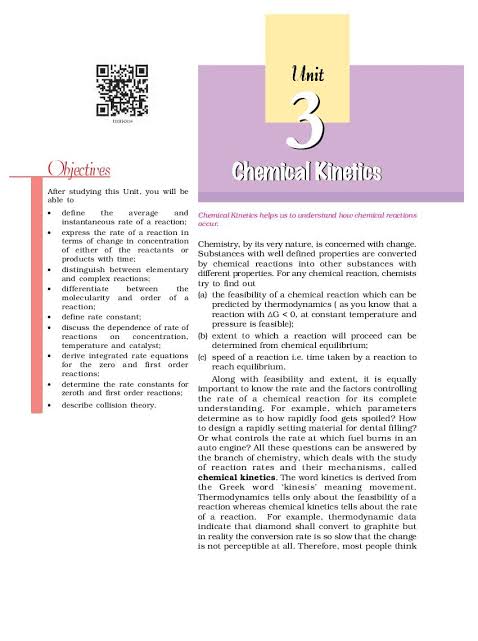Chemical Kinetics is an essential chapter in Class 12 Chemistry that focuses on the rates of chemical reactions and the factors that influence these rates. Understanding this chapter is crucial for several reasons:Understanding
Reaction Rates: Chemical Kinetics helps us comprehend how fast or slow a reaction occurs. This knowledge is vital in various fields, including pharmaceuticals, where reaction rates can determine the effectiveness of drugs, and in industries, where controlling reaction speed is crucial for optimizing production.
Factors Affecting Reaction Rates: The chapter discusses various factors that influence reaction rates, such as temperature, concentration of reactants, catalysts, and surface area. This knowledge allows chemists to manipulate these factors to achieve desired reaction rates in different chemical processes.
Rate Laws and Order of Reactions: Chemical Kinetics introduces the concept of rate laws, which mathematically express the relationship between the rate of a reaction and the concentration of reactants. Understanding the order of a reaction helps predict how changes in concentration affect the reaction rate.
Collision Theory: The chapter explains the collision theory, which states that for a reaction to occur, reactant particles must collide with sufficient energy and proper orientation. This theory provides a microscopic understanding of how reactions happen at the molecular level.
Applications in Real Life: Chemical Kinetics is widely applicable in real-life scenarios, such as determining the shelf life of products, controlling pollution through catalytic converters, and even in understanding natural processes like enzyme activity in biological systems.
Overall, mastering Chemical Kinetics is essential for a deeper understanding of how chemical reactions occur, how to control them, and their implications in both industrial and natural processes.

Class 12th chemistry Chapter 3 Chemical kinetics PDF Book 📚 download
Short Questions
What is electrochemistry?
Answer: Electrochemistry is the branch of chemistry that deals with the relationship between electrical energy and chemical reactions, particularly redox reactions that involve the transfer of electrons.
Define electrode potential.
Answer: Electrode potential is the potential difference developed between an electrode and its electrolyte when the electrode is in equilibrium with its ions in the solution.
What is the standard electrode potential?
Answer: The standard electrode potential is the potential of a half-cell under standard conditions (298 K, 1 M concentration, and 1 atm pressure) relative to the standard hydrogen electrode (SHE).
What is the Nernst equation?
Answer: The Nernst equation relates the electrode potential of a half-cell to the standard electrode potential, temperature, and the activities (or concentrations) of the chemical species involved.
Define Faraday’s laws of electrolysis.
Answer: Faraday’s First Law states that the amount of substance deposited or liberated at an electrode is directly proportional to the amount of charge passed.
Faraday’s Second Law states that the amounts of different substances liberated by the same amount of charge are proportional to their equivalent weights.
What is a galvanic cell?
Answer: A galvanic cell is an electrochemical cell that converts chemical energy into electrical energy through spontaneous redox reactions.
What is the significance of the salt bridge in a galvanic cell?
Answer: The salt bridge maintains electrical neutrality within the internal circuit of a galvanic cell by allowing the migration of ions, preventing the buildup of charge.
What is a concentration cell?
Answer: A concentration cell is an electrochemical cell where the electrodes are identical, but the electrolyte concentrations are different, leading to a potential difference between the electrodes.
Explain the term ‘cell potential’.
Answer: Cell potential, also known as electromotive force (EMF), is the potential difference between the two electrodes of a galvanic cell when no current is flowing.
What is the electrochemical series?
Answer: The electrochemical series is a list of standard electrode potentials of different elements arranged in order of increasing reduction potential.
Long Questions
Explain the working of a galvanic cell with an example.
Derive the Nernst equation for a single electrode potential.
Discuss the application of electrochemistry in batteries and fuel cells.
What are the factors affecting the electrode potential?
Explain the concept of corrosion and its prevention.
Describe the working principle of a potentiometer in measuring EMF.
Class 12th chemistry Chapter 3 Chemical kinetics, Handwritten notes Download PDF file 🗄️
👇👇👇👇

Get involved!
Comments